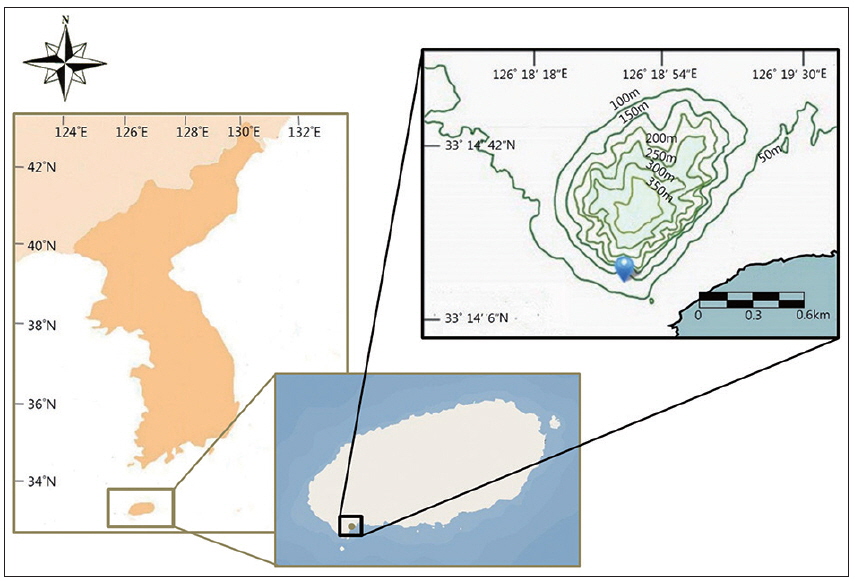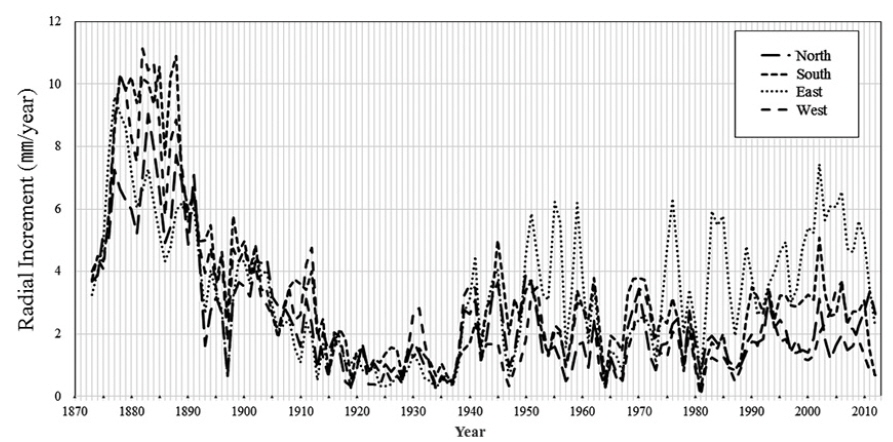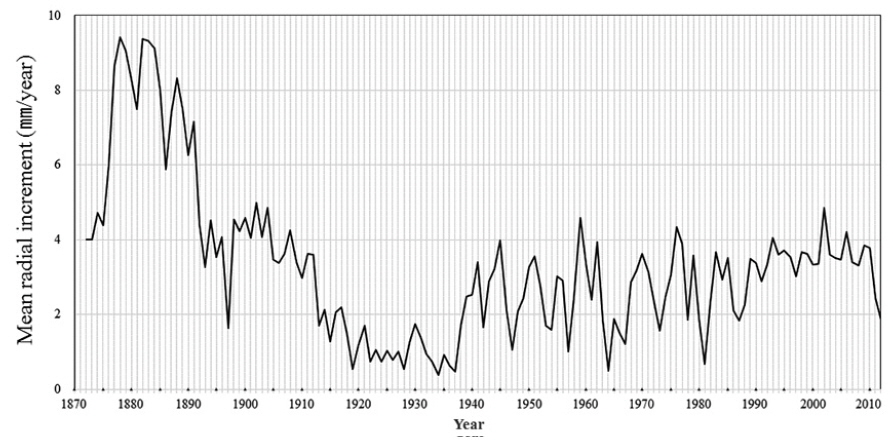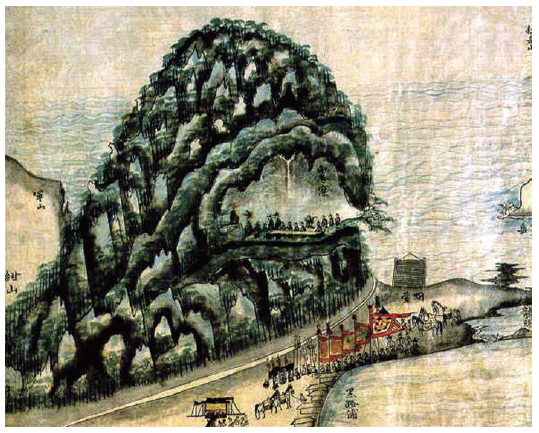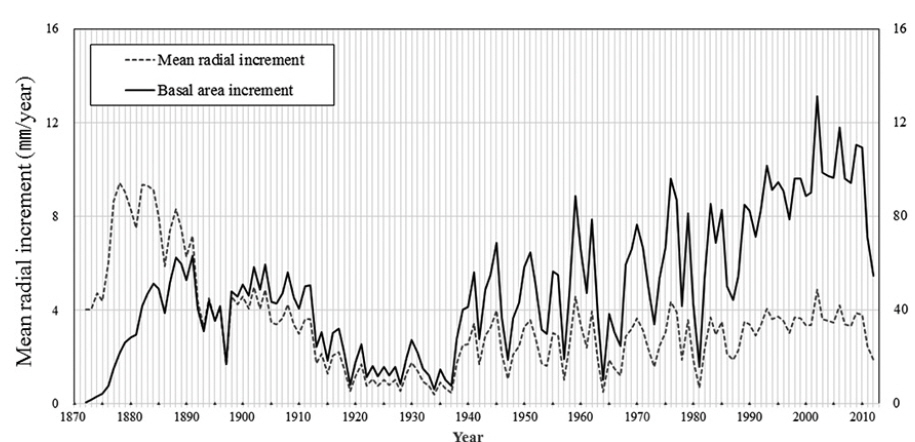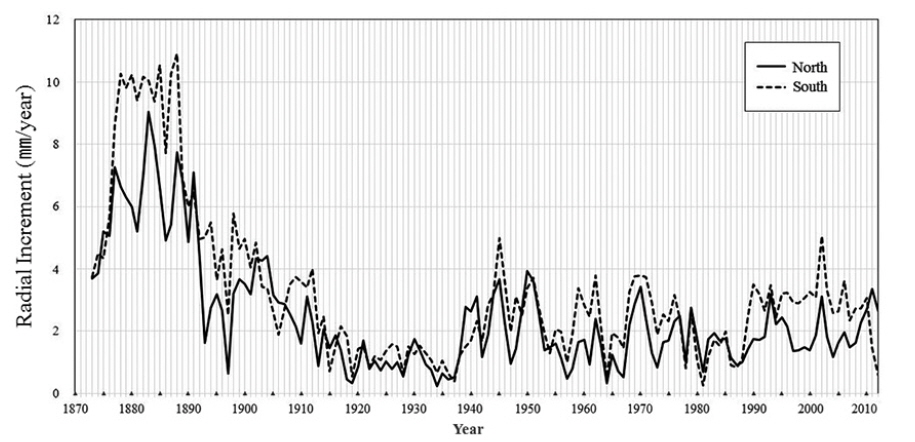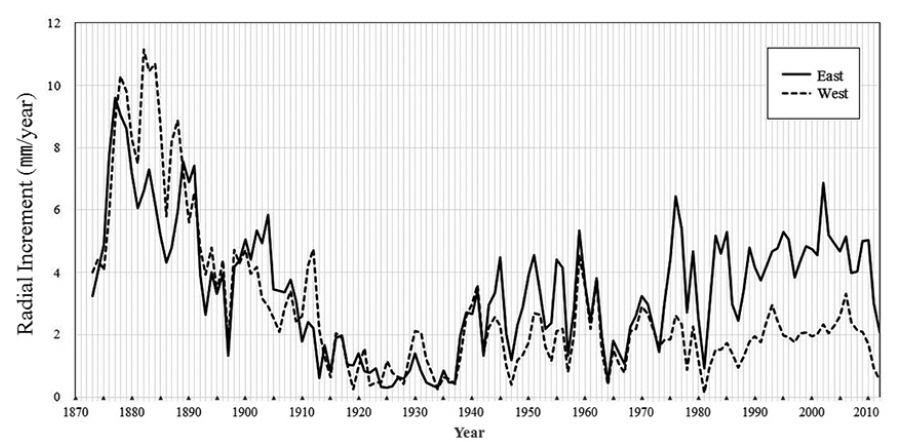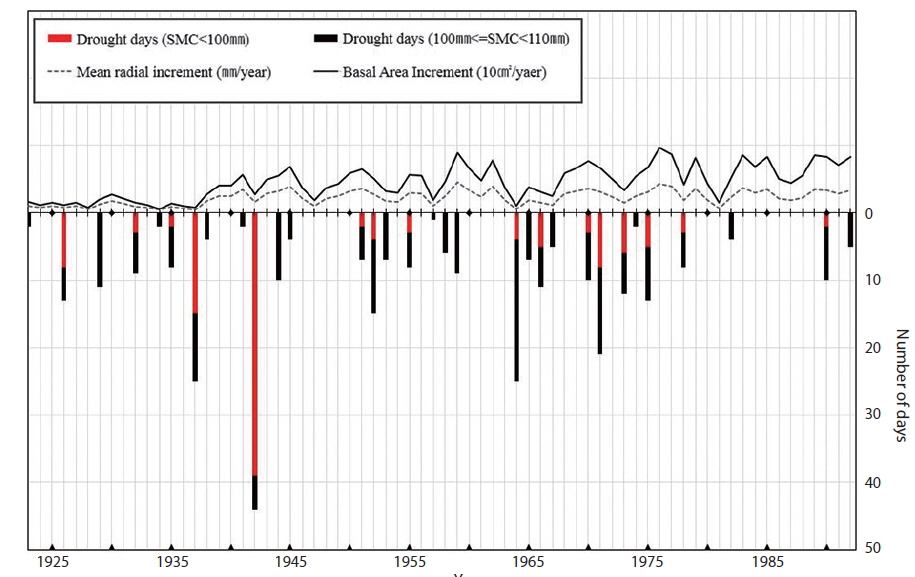



In April 2014, at the Cave Temple on Mt. Sanbangsan, Jeju, Korea, an old black pine (
Pine wilt disease caused by pine wood nematodes is one of the major tree disease that affect severely pine forests in Korea. Pine wood nematode,
In Korea, pine wilt disease was first detected at Mt. Gumjungsan, Pusan city in 1988. Most damaged tree species are red pine (
Tree age can be accurately estimated by examining the increments of tree rings from the lower tree stems (Fritts 1976, Schweingruber 1993, Kim 1993, 1994). If discs of lower stems of trees can be obtained, we can estimate ages of the trees correctly. Conventionally, the stems of affected trees by the pine wilt disease are strictly prohibited to be removed from the site. The timbers of the infected trees should be chemically fumigated and buried on site, so it was impossible to examine the tree rings of the infected trees. Recently, the Korea Forest Research Institute developed a new technology to thermally disinfect timbers and made it possible to utilize the treated timbers for other purposes. It was possible for us to obtain the thermally treated and sanitized disc of lower stem of the tree from the Korea Forest Research Institute and we measured the increments of the tree rings from different directions and estimated the age of the tree. By synthesizing the information from the tree ring data, we interpreted the life history of the black pine tree on Mt. Sanbangsan, Jeju, Korea.
The objectives of this study are to accurately estimate the age of the tree, to interpret the life history of the tree, and to further extend the discussion on the protection of pine trees from potential damages related to tree diseases such as pine wilt disease in Jeju, Korea.
The tree for this study was growing at a location with latitude at 33°14′17″ N and longitude at 126°18′46″ E (Fig. 1), Andeok-Myon, Seogwipo City, Jeju Special Self-Governing Province, Korea. The diameter at breast height (DBH) and the height of the tree were 95 cm and 12 m, respectively. With the cooperation from the Seogwipo City Government and the Warm-Temperate and Subtropical Forest Research Center of the Korea Forest Research Institute, we acquired the thermally treated and sanitized sample of disc of the stem of the black pine tree taken from the height of 2 m. The diameters of the woody parts of the disc were 87.0 cm from east to west direction and 80.0 cm from south to north direction.
The disc of the tree was sanded, first by coarse belt sander with grit size 100, and further fine-sanded with sand papers with grit sizes from 220 to 800 to clearly distinguish the borders of the annual rings of trees from the sample disc. The increments of the tree rings were read from most recent one to the pith from 4 different directions (north, south, east, and west) with its resolution of 0.001 mm by using TREE Ring Reading System and TSAPWin Program (LINTABTM5; LINNTECH Company, Germany) at the Laboratory of Environment and Ecology, Kookmin University. The data of increments of tree rings were mutually compared and their synchrony was checked to ensure the correct reading of the tree rings. In order to ensure the correct reading of the radial increments, we cross-dated the readings by checking the synchrony of the years of reduced growth with the years of drought with the records simulated from the BROOK Model (Federer and Lash 1978, Federer 1993, Kim and Kim 2000, Kim 2010a, 2010b).
The reading the distance between the borders of tree rings indicates the radial increment of the tree, which is about half of the diameter increment of the tree. The first step to check the validity of the correct reading is to check the synchrony of the radial increment data read from 4 different directions of the sampled disc. Fig. 2 shows the radial increment data read from 4 different directions. It is interesting to note that the readings of the tree rings shows a good synchrony among themselves, which indicates that reading records of the tree rings were fine without any problem.
Fig. 3 shows the mean radial increment of the tree since 1870s. It indicates that tree grew in average 3.37 mm per year in radius, which means that it grew in average 6.74 mm per year in diameter. The amounts of the growth were highest during the period of 1877-1891 and lowest during the period of 1913-1937. While the radial increments in recent years were not generally decreasing, those in 2011-2012 decreased very sharply, which will be mentioned again in this paper.
We can interpret life history of the tree in growth and leaning by examining the patterns of the radial increment of the tree. There are several stages of interest in interpreting the life history of the tree. Firstly, it is interesting to note that the tree has grown very fast from the beginning in late 1860s. Although we can’t exclude the possibility for the tree to have been artificially planted, it is highly possible for the tree to have been naturally regenerated because we could observe the increasing patterns of radial growth during 1872-1878, which is a typical phenomenon that can be observed from the radial growth of naturally regenerated trees. Secondly, we observed a sharp decrease in radial growth in 1892-1893, and again in 1897, which resulted in the reduced growth for more than 10 years. Currently, it is not clear about the causes for the abrupt reduction in radial growth of the tree, but drought may be one of the factors affecting the growth reduction. Thirdly, radial growth was reduced very much since 1913 and it continued until 1937. The cause for this kind of growth reduction may be ascribed to widely prevalent forest insects, such as pine moth, etc., but at this moment, we do not have any information about them to prove it, however. Fourthly, the tree recovered its radial growth since 1938 and showed fluctuating but stabilized and slightly increasing trend until 2010. Fifthly, the tree died in 2013 by the prevalence of pine wilt disease with the clear symptoms of dried needles with its needle color completely changed to a tan to brown color from its normal color. It is worth to pay a special attention to the sharp decrease in radial increment of the last two years in 2011 and 2012 before its death in 2013.
From this study, we could find that there were several years that showed rapid reduction in radial increment, which were the years of 1886, 1892-1893, 1897, 1913, 1919, 1941, 1946-1947, 1957, 1961, 1963-1964, 1972-1973, 1978, 1980-1981, 1986-1987, and 2011-2012. The reasons why the trees showed sudden reduction in radial growth are not clear at this moment and should be further investigated. However, we can postulate that one of the factors responsible was drought phenomenon, which commonly affect tree growth quite significantly in Korea (Kim and Kim 2000, Kim 2010a, 2010b).
In terms of the potential damages by typhoons, it is difficult to postulate that the typhoons were the causal factors for the death of the tree. Generally, typhoons cause abrupt leaning and wind fall of the stems of the trees in forests. As the tree was located in a southern slope of the mountain against Mt. Sanbangsan, the tree was rather securely protected from the strong winds including typhoons. In other words, Mt. Sanbangsan played the role of windbreak for the tree, resulting in the protection of the tree from the typhoons. Therefore, we can safely rule out the typhoons as the causal factor for the death of the tree.
Another interesting finding to support the argument stated above was that, in 2013, only spring wood (early wood) was formed in the annual ring of the tree, which meant that the tree might have stopped its radial growth at its earlier stage of the growing season, possibly in May, June or early July, resulting in the failure in the formation of summer wood (late wood) of the tree before the major typhoon season in mid-July to late August of the year.
We could count 142 annual rings of the tree up to 1872, which means that the tree had grown for 142 years above the height of sampled disc of the tree stem. Adding a few more years (e.g., 5-7 years) for the tree to grow up to the height of the sampled disc of the tree stem, the age of the tree was estimated to be at maximum 150 years when the tree died in 2013.
Originally, this study was initiated with the motivation that the tree was old enough for us to examine its tree rings exceeding 300 in number, because it was believed to be the same tree as was drawn in a painting of the Tam-Ra-Sun-Ryeok-Do published in 1702 (Fig. 4). In order to justify this, the number of the tree rings should be far more than 312, representing the number of years since the year of the drawing of the tree in 1702 until the year of the death of the tree in 2013. We report that we could not find any evidence that the tree can have tree rings more than 150 in number.
Contrary to the belief of the general public, we could conclude that the tree was not the same old tree as was drawn in the painting of the Tam-Ra-Sun-Ryeok-Do published in 1702. People believed that the tree was more than 400 or about 600 years old because they believed it was the same tree as was in the painting. Generally, some professionals as well as the public in Korea have the tendency to over-estimate the ages of old trees. Kim (2003) analyzed tree ring series of a lace-bark pine (
>
Characteristics of basal area increment of the tree
The basal area increment of trees is the better indicator than the radial increment of trees in growth and the volume increment of trees is the best indicator of tree growth. In order to calculate the volume increment of trees, we additionally need the data and information on height growth on annual basis, but it is very difficult to establish them for further studies. In this condition, it is rather simple to calculate basal area increment from the data of mean radial increment of trees.
Using the data of the mean radial increment of the tree, basal area increment of the tree was calculated and plotted as is shown in Fig. 5. Generally, the patterns of the basal area increment were similar to those of the radial increment. It is quite interesting to note that the basal area increments continued to increase since 1938 after the recovery period from prolonged low growth during 1913-1937 and that the tree showed fluctuating but steadily increasing trend until 2010. As it was pointed out earlier related to the sharp decrease in the radial increment of the tree during the last two years in 2011 and 2012 before its death in 2013, the amount of the basal area increment in 2012 was about half of that during 2009-2010. Obviously, there were possibilities that infection of pine wood nematode could affect the growth of the tree. Especially to the bigger tree, such as the big black pine tree at the Cave Temple on Mt. Sanbangsan, it might take longer time to induce disease symptoms than to smaller trees. It is worthwhile to pay attention to further investigate what are the growth responses of bigger pine trees affected by the pine wood nematodes.
At the Cave Temple on Mt. Sanbangsan, the tree was growing leant about 30 degrees downward south-eastern slope. When coniferous trees are exposed to the prevailing winds growing on slopes, or affected by gravity toward certain direction, they form compression woods by putting more woods to the opposite sides of the wind or imposing power or the direction toward the lower slopes.
Comparison of the radial increment to north direction in the disc with that to south direction shows how the leaning was proceeded during the life span of the tree. In Fig. 6, the tree showed higher growth in radius toward south side than that toward north side during the periods of late 1870s to 1880s, early 1890s to early 1900s, and continues from late 1900s to the very recent years.
Comparison of the radial increment to east direction in the disc with that to west direction shows how the leaning was additionally proceeded for the life span of the tree. In Fig. 7, the tree showed higher growth in radius toward east side than that toward west side since 1940s, especially since mid-1970s. It is interesting to note that the tree showed initially more rapid growth to west side during late 1870s to late 1880s.
By integrating this information, we can interpret that the tree initially leaned south-westerly since 1870s and continued to gradually lean toward south-easterly since mid-1940s. It is interesting to note that the tree leaned toward south-easterly since 1980s even more.
>
Drought response of the tree
In order to check how the tree responded in radial growth by the droughts affecting nature in Jeju, we compared the length of days for simulated drought phenomena (Kim and Kim 2000, Kim 2010a, 2010b) with the patterns of the tree growth in radial increment and basal area increment. As the simulated drought data are only available during the period of 1927-1998, full comparison for the life span of the tree was limited only to the period (Fig. 8). Interestingly, the reduced growth in 1964, 1942, and 1973 was related to the drought affected the Jeju area. This comparison also allowed us the assurance of the correct reading of the radial growth of the tree.
It is quite regrettable to see this tree and many other pine trees have died and are dying by the pine wilt disease in major parts of pine forests in Jeju as well as other provinces in Korea. We should point out that major measures should be taken to ensure the secure protection of pine trees from this disease.
Meanwhile, it is interesting to observe that it took more than one season for the tree went to mortality before the death of the tree and that the tree showed a sharp decrease in radial increment during the last two years in 2011-2012 before its death in 2013. Although it is not clear why it took more than a season for the pine wood nematodes to cause the tree to die, there are possibilities to support the positive relationship between the decrease in radial increment and pine wilt disease infection.
Symptom development of pine wilt disease is determined by various factors such as temperature, nematode infection time, the number of nematodes infected, and also physiological condition of the tree (Kiyohara and Tokushige 1971, Shoji and Jinno 1985, Halik and Bergdahl 1994). Even though most of the trees infected by pine wood nematode died in several months, some of them could survive for a while without any symptoms. We call the trees as “asymptomatic trees” (Bergdahl and Halik 1999, Takeuchi and Futai 2007). Kishi (1995) reported that the initial distinct symptoms such as dysfunction of oleoresin exudation and needle discoloration appeared during any season, but the symptom development was delayed until the following season. Takeuchi and Futai (2007) also found that some asymptomatic trees of
Overall, careful preparation of the samples and fine reading of the tree rings allow us to know exactly about the age as well as the life history of the old trees, which can be further extended for the better interpretation of the natural phenomena scientifically in the forests of Korea.
